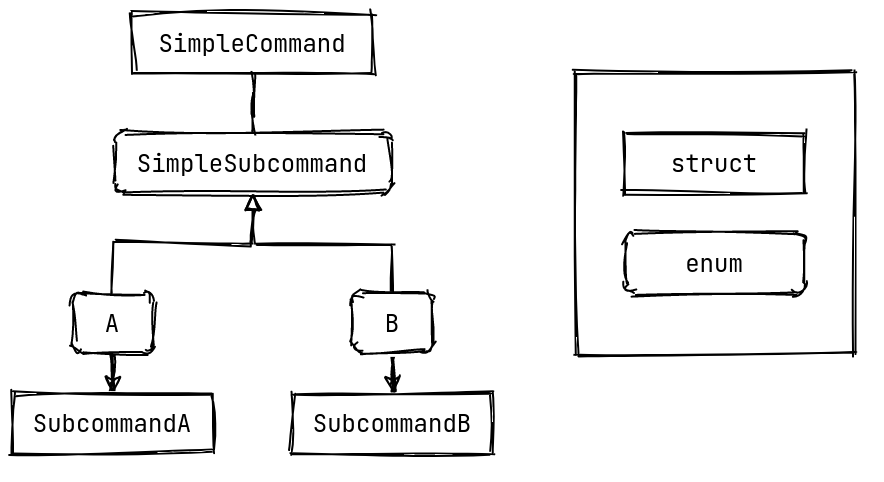Project Anni 的第一笔 commit 是从去年(2020年)12月20号开始的,而 clap 则是在当天的第三个 commit 中引入的。当时引入的是 2.3.3,也就是 clap 2 的最后一个版本,这个版本中还没有 derive 的身影。随着 clap 3.0.0-beta 版本的发布,带着尝鲜的心情,anni 的 clap 版本也悄然升级。但依然只是使用了传统的 builder 方式,并没有关注 clap_derive。

但随着 anni-cli 功能的不断增多与复杂化,传统的方式开始越来越不能满足需要了。以字符串形式约定的 value_of,层层传递的 matches,手动进行的参数类型转换,这一切都令人心生退意。随着参数的增加,情况只会越来越糟,在现有的模式下,基本看不到变好的可能……
于是,从 builder 到 derive 的迁移之旅就开始了。
ToC
回顾:builder 模式
回头望去,不难发现 builder 模式其实是很符合人类直觉的一种方式。在默认的基础上进行改动,并最终拼凑成形。我们以现在 Readme 为例:
let matches = App::new("My Super Program") .version("1.0") .about("Does awesome things") .arg(Arg::new("config") .short('c') .long("config") .value_name("FILE") .about("Sets a custom config file") .takes_value(true)) .arg(Arg::new("INPUT") .about("Sets the input file to use") .required(true) .index(1)) .arg(Arg::new("v") .short('v') .multiple_occurrences(true) .takes_value(true) .about("Sets the level of verbosity")) .subcommand(App::new("test") .about("controls testing features") .version("1.3") .arg(Arg::new("debug") .short('d') .about("print debug information verbosely"))) .get_matches();
// You can check the value provided by positional arguments, or option arguments if let Some(i) = matches.value_of("INPUT") { println!("Value for input: {}", i); }
if let Some(c) = matches.value_of("config") { println!("Value for config: {}", c); }
// You can see how many times a particular flag or argument occurred // Note, only flags can have multiple occurrences match matches.occurrences_of("v") { 0 => println!("Verbose mode is off"), 1 => println!("Verbose mode is kind of on"), 2 => println!("Verbose mode is on"), _ => println!("Don't be crazy"), }
// You can check for the existence of subcommands, and if found use their // matches just as you would the top level app if let Some(ref matches) = matches.subcommand_matches("test") { // "$ myapp test" was run if matches.is_present("debug") { // "$ myapp test -d" was run println!("Printing debug info..."); } else { println!("Printing normally..."); } }这种模式看起来很灵活,实际使用时也确实很灵活,但这种灵活性也是有代价的。
肉眼可见的就是代码长度。可以看到这种模式下,我们并没有太多的功能,但却用了足足 57 行代码来描述这些参数和功能。
其次是参数的类型。通过 value_of 和 values_of 获得的内容都是字符串(数组),这意味着当我们需要的参数类型并非字符串时,势必需要在某个地方对它们的类型进行转换。而这样的类型转换又会带来新的问题:是否要持久化转换后的参数?如果不持久化,那么在下次使用同一参数时又需要再重复一次反序列化的操作;但如果持久化,那我们又必须建立持久化对应的结构体,并手动创建它们;又或是在某一个较高层级对参数的类型进行调整,然后一级一级送下去?然后你就得到了一幅以 matches 为底,高层参数内容组成的结构体为边的等腰直角三角形
从 builder 到 derive
从 builder 到 derive 的思想非常简单:将命令替换成 struct,子命令替换成 enum。以 anni repo 子命令为例,替换后的代码如下:
// 顶层命令// 包含了 root 属性和不同的 subcommand#[derive(Clap, Debug)]pub struct RepoSubcommand { #[clap(long, env = "ANNI_REPO")] root: PathBuf,
#[clap(subcommand)] action: RepoAction,}
// 第二层的 Subcommand// 包含各个子命令的声明方式#[derive(Clap, Debug)]pub enum RepoAction { Add(RepoAddAction), Edit(RepoEditAction), Apply(RepoApplyAction), Validate(RepoValidateAction), Print(RepoPrintAction),}
// 第三层的命令// 实际执行的操作#[derive(Clap, Debug)]pub struct RepoAddAction { #[clap(short = 'e', long)] open_editor: bool,
#[clap(required = true)] directories: Vec<PathBuf>,}首先我们需要 #[derive(Clap)],可以选择 Debug 以在解析结束之后输出解析结果,方便调试;然后我们需要通过 #[clap(xxx)] 表示每个参数的详细属性。比如 short 和 long。这些参数可以简单地和 builder 中的同名函数对应,这里就不再展开了。
处理 Subcommand
——命令解析成功,我们得到了一个完整的 struct,代表了用户的具体输入。下一步就是处理了。
我们知道,一个 struct 代表了一种命令,而一个 enum 则代表了一个子命令。 struct 与 enum 交替嵌套,形成了整个工具。如果想要实现简单的处理逻辑,就要从顶层的 command 开始,逐层匹配是否命中对应的 subcommand。
举一个简单的例子吧,只有一层子命令的情况:
#[derive(Clap)]struct SimpleCommand { #[clap(subcommand)] subcommand: SimpleSubcommand;}
#[clap(Clap)]enum SimpleSubcommand { A(SubcommandA), B(SubcommandB),}
#[clap(Clap)]struct SubcommandA { #[clap(short, long)] arg1: String,}
#[clap(Clap)]struct SubcommandB { #[clap(short, long)] arg2: String,}可以看到,最外层的命令只有一个,是 SimpleCommand;在这个命令中有两个 Subcommand,对应了两个命令各自的结构体。简单的层级关系如下图所示:

图中,我们将 SimpleCommand 称为根命令,SubcommandA 和 SubcommandB 称为子命令。特别地,在只有一层子命令嵌套的关系下,我们还可以把这两个子命令称为叶子命令。
那想要解析 SubcommandA,我们需要做什么呢?
不难发现,想要到达 SubcommandA,我们需要经过 SimpleCommand 和 SimpleSubcommand 两层。根据从上到下的解析顺序,只要我们给每一个层级增加一个 handle 函数,再对每一个 struct 和 enum 都实现这个方法,最终就可以通过调用根命令的 handle 来处理整个树的执行了。
对于 SimpleCommand,由于其拥有子命令,因此结构体中必定存在一个 #[clap(subcommand)] 的字段表示所属的子命令;而对于 SimpleSubcommand,其 enum 中每一个 variant 都实际对应了一个子命令。因此这两部分都能简单地通过过程宏实现。
pub trait Handle { fn handle(&self) -> anyhow::Result<()>;}
#[proc_macro_derive(ClapHandler)]pub fn derive_clap_handler(item: TokenStream) -> TokenStream { let input = parse_macro_input!(item as DeriveInput); let name = &input.ident;
let expanded = match input.data { Data::Struct(DataStruct { ref fields, .. }) => { match fields { Fields::Named(ref fields_name) => { // find struct field which has #[clap(subcommand)] let subcommand_field: Option<syn::Ident> = fields_name .named .iter() .find_map(|field| { for attr in field.attrs.iter() { if attr.path.is_ident("clap") { let ident: syn::Ident = attr.parse_args().ok()?; if ident == "subcommand" { return Some(field.ident.clone().unwrap()); } } } None }) .expect("Failed to find #[clap(subcommand)] in struct!");
quote! { impl Handle for #name { fn handle(&self) -> anyhow::Result<()> { self.#subcommand_field.handle() } } } } _ => panic!("ClapHandler is not implemented for unnamed or None struct"), } } Data::Enum(DataEnum { variants, .. }) => { // list enum variants let subcommands: Vec<_> = variants .iter() .map(|v| { let ident = &v.ident; quote! { #name::#ident } }) .collect();
quote! { impl Handler for #name { #[inline(always)] fn handle(&self) -> anyhow::Result<()> { match self { #(#subcommands(s) => s.handle(),)* } } } } } _ => panic!("ClapHandler is not implemented for union type"), }; expanded.into()}RE:thonk
好,回答一个问题:这样就够了吗?
考虑这样一种情形。顶层的 Command 读取配置并构造了一个 ABCManager,而子命令则需要根据 ABCManager 的 A、B、C 三种不同方法进行处理,同时需要读入各自不同的参数。
很自然地,我们将 A、B、C 归为三个(叶)子命令。但这样的话,问题就出现了。我们的叶子命令 A 需要依赖上一层命令解析得到的结果 ABCManager,而这在现有的体系下是无法做到的。我们的 trait Handle 只支持了无参数的 handle 方法,怎样才能把参数传递下去呢?
最简单的想法就是直接把参数传递下去,这也是目前 Anni 使用的方案。这种方案简单粗暴,但也存在着很大的问题。最大的问题就是可扩展性太差了,很难处理复杂的依赖情况,但对目前的 Anni 而言也还算足够,于是就这样先用着了。
但实际上,对于实际执行到叶子命令,我们还可以提供更多的依赖信息。观察命令解析的树,不难发现,子命令的解析实际上就是在寻找一条到对应 Subcommand 的路径。而在这条路径中,同级的其他子命令是不会被执行的。也就是说,对于这个寻找的过程而言,其完全可以把所有权交给下一级的处理者——也就是 self 而非 &self。对于实际执行的叶子命令,其完全可以获得一个 Owned 的,能够逐级反推最后得到根命令 struct 的参数。
结语
从 builder 到 derive,Anni 的命令解析终于进入了可维护的轨道,但这也只是刚刚开始。正如 RE:thonk 部分所描述的,目前使用的方案还是最简单粗暴的。并且由于个人对宏的了解尚浅,现在的实现可以说是把头都绕没了,还有很大的改进空间。
Anni 的旅程也远不止 clap 那么简单。恰恰相反,clap 只是整个工具的第一步。从 Project Anni 的编写过程中所学到的,就静侯后续的其他记录吧。